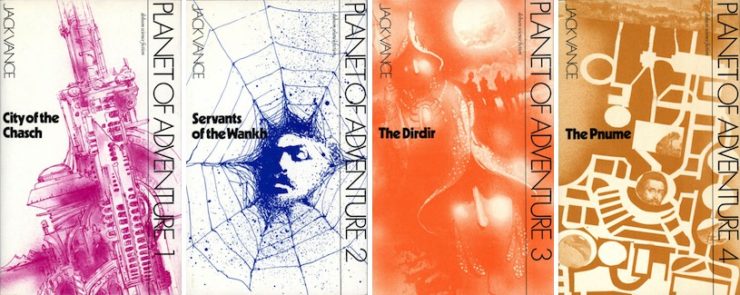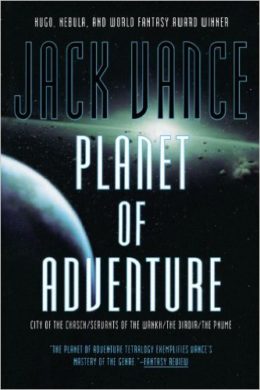Adam Reith is a scout aboard the Explorator IV, a research and scouting vessel of a future Earth that is expanding into the stars.¹ A scout, to quote Chief Officer Deale, is “half acrobat, half mad scientist, half cat burglar” and more: “A man who likes change.” Reith gets his fill of that last, as his ship investigates a planet around the star Carina 4269, 212 light years from Earth. A faint radio signal has reached the vicinity of Earth from the planet, a signal that ended abruptly. So, someone sent a signal 200 years ago, but who? And why did the signal end?
The Explorator IV is destroyed by a surprise attack of space torpedoes from the planet. The only survivors turn out to be Reith and his fellow scout Paul Waunder, who were sent in a separate vessel to get closer to the planet. One crash landing later, Adam Reith is stranded on the torpedo-firing alien planet. An alien planet that has not only aliens on it, but, unexpectedly and shockingly, humans, as well—humans that were brought there long ago, in human prehistory. Therefore the aliens on the planet know about Earth, and are a threat to humanity. Adam Reith’s mission is to find a way off of this strange world, find a means to get back home, and warn Earth of the alien threat.
The four novels of Jack Vance’s Planet of Adventure Tetralogy, tell the story of Reith’s crash landing on Tschai, the eponymous Planet of Adventure, and his unceasing, relentless efforts to find a way to escape it and return home. His fellow scout Paul Waunder is quickly killed, leaving him as the sole Earthman on the planet.
The four novels are named for the alien races who inhabit Tschai, and with whom Reith tangleh in order to effectuate his escape:
- City of the Chasch (1968)
- The Wannek² (1969)
- The Dirdir (1969)
- The Pnume (1970)
No man is an island, and Reith quickly gains two companions who loyally stay by his side through his adventures. Traz is a human of a steppe culture, the Emblem Men, a group of humans who are not aligned with any of the alien races and are as such looked down as “sub men.” It is to the Emblem Men that Reith is first brought after his crash landing, and it’s from them and Traz in particular that Reith starts piecing together basic information about the planet. When Traz’s standing in the tribe is challenged, thanks to the disruption that Reith’s arrival has caused, Traz joins Reith in his journey across the planet.
For more detailed information on the world and its peoples, the series relies heavily on Ankhe at afram Anacho, or Anacho. Anacho is a Dirdirman, the race of men who are aligned with the tall, pale alien race called the Dirdir. Anacho is an exile from his own people and the Dirdir and so, having nothing better to do at first, joins with Reith and Traz on their quest when they meet on a caravan headed (Reith hopes) toward the location of his crashed space boat.
As Reith travels across the face of the planet in the four novels, both men stay by his side, even as Reith offers them the opportunity time and again to abandon his quest and make their own way, often with a rather handsome profit for their trouble. Reith does gain and lose a number of fortunes in his adventures, with the aim for him each time of using those funds to try and get off of Tschai. The trio of characters make for a psychological study in contrasts. Traz, the man of action, always ready to take things to a fight if needed; Anacho, the cool, detached, polished libertine intellectual; and Adam Reith in between, a genius bruiser who is excellent in a fight, but is also a renaissance man with a surprising range of skills. They quarrel, they bicker, and they have adventures together. Reith is our only point of view character, and we remain resolutely in his head for the most part, while his companions provide the perspective that readers need to truly understand the planet and its peoples.

When first I discovered the Planet of Adventure novels, decades ago, it was among the first science fiction novels I’d ever read. I was reading then for the sense of wonder, for adventure, for exotic and alien landscapes that I could visit in my head. Tschai, bathed in the soft light of the aged star Carina 4269, fit the bill and then some. Mysterious alien-built cities, vast steppes, journeys across the world on caravans, sailing ships, and flying cars. Decaying and decadent courts of intrigue, crowded market bazaars, a deadly park contained within a building. Gunmetal skies and amber sunlight giving an exotic cast to everything. Haunted forests lit by the two moons of Tschai. Strange customs and societies, a hallmark of Vance’s fiction, populate (and almost overcrowd) the world. What is near-mandatory in one region of Tschai will get you killed in another. Anyone who despairs of planets in SF which feature all the same terrain and the same people have never visited Tschai. This variety and diversity is such that most people who encounter Reith and hear his story just think he’s from some corner of Tschai that they are unaware of, and probably crazy to boot. For much of the first couple of novels, Anacho is in fact convinced of this. Traz, though, who was present for his crash landing, knows better from the start.
But of all the locations on Tschai, it is the Carabas that stands out as one of the most evocative and memorable places in all the locations in the world of SF I’ve ever visited. The main currency on Tschai are sequins, made out of a uranium mineral called chrysospine. Nodes of this mineral grow, like crystals, in the Carabas, the Dirdir hunting preserve. Anyone can go into the preserve and look for sequins. Purple are best, worth a hundred of the base clear sequins. Other lesser colors also exist in between. Anyone is welcome to go and dig up as many sequins as you can carry. The trick is that the Dirdir and Dirdirmen are equally welcome to try and track down any and all prospectors, and kill anyone they catch…and probably eat them. Replete with a border town to sell over-priced lodging, tools, maps, and more to visitors, the dusty badlands of the Carabas is like the deadliest western frontier gold rush territory you can possibly imagine. And Reith’s solution to the problem of how to profit at such a rigged, deadly game is bold, and brilliant.
The novels do fall down when it comes to the relative lack of women in the story. These books really are male-centric SF adventure, with a male gaze, a male point of view and male characters. Women do exist in the story, in both positive and negative roles, but given the tight focus on Reith and his adventures, we rarely get a good feel for what the life of a woman is like on Tschai.
It’s not all bad, however Events in the first two novels are driven somewhat by Ylin-Ylan, the Flower of Cath, a captive that Reith falls for, and whom he frees from bondage and preparation for sacrifice. As it was her people, two centuries earlier, that sent the signal that brought Reith to the first place, Reith agrees to lead her back home, hoping that he might build a spaceship to get off the planet. This, however, ends tragically, and badly, for all concerned.
The other major female character appears in the last novel, The Pnume, and that is Zap 210. As one of the Pnumekin, the humans aligned with that underground, secretive race, it quickly becomes clear to Reith that the Pnume have used drugs to alter their human specimens even more than the Dirdirmen or Wannekmen or Chaschmen have. Zap’s story focuses on her overcoming those alterations, those drugs, those changes, and maturing into a full human. Crucially, the novel has Reith, who has been skittish about female companionship since the tragedy of Ylin-Ylan, also undergo a change of a different nature, and the Reith that finally escapes the Pnume underworld is much changed from the man that went in. Reith, who has remained relatively unchanged through the first three novels, undergoes significant and striking character growth in the fourth novel, and the influence of Zap 210 is crucial to that development.
Overall, the sheer sense of relentless adventure, endless variation and invention in worldbuilding, and the grand, single, simple narrative of a man trying to get home by any means makes Planet of Adventure one of the greatest stories in Vance’s oeuvre. The planetary romance—which quickly discards most trappings of science fiction gadgetry (never a strong suit in Vance’s work) in favor of a more primitive existence, in most cases—is a strength here, as it helps make the novels timeless. Tschai will always be revolving around its aged yellow star, filled with its peoples, aliens, landscapes, and adventures, waiting for new readers to pay it a visit. I urge you to do so.
¹The actual date on Earth is never specifically outlined. Reith mentions ten thousand years of history, which suggests that if he’s dating back to Ancient Egypt or Mesopotamia that we’re somewhere around 5000 AD. Amusingly, Anocho tells him that the ten thousand years of human history Reith brings up can’t compare to the fifty two thousand years men have been on Tschai—therefore Reith’s idea of humans being from Earth is just crazy. Humans, are, in Anocho’s view, from the Dirdir home planet of Sibol, and came with the Dirdir to Tschai.
²The Wannek was originally titled Servants of the Wankh. Neither the author nor the publisher realized the unfortunate British English connotations of the original title. With the republication of all of Vance’s work under the Vance Integral Editions, the title has been changed to The Wannek, and all references to Wankh and Wankhmen changed to suit. Less drastically, the Vance Integral Editions changed the title of the first volume from The City of the Chasch to simply The Chasch.
An ex-pat New Yorker living in Minnesota, Paul Weimer has been reading sci-fi and fantasy for over 30 years. An avid and enthusiastic amateur photographer, blogger and podcaster, Paul primarily contributes to the Skiffy and Fanty Show as blogger and podcaster, and the SFF Audio podcast. If you’ve spent any time reading about SFF online, you’ve probably read one of his blog comments or tweets (he’s @PrinceJvstin).










